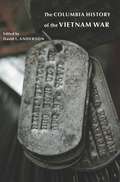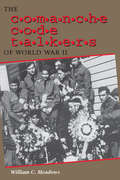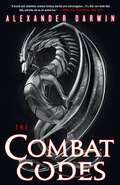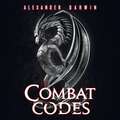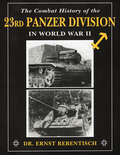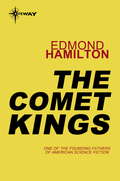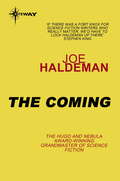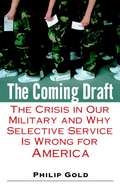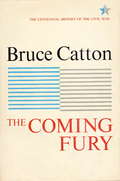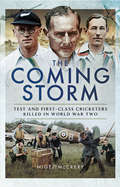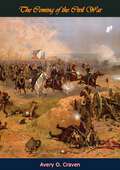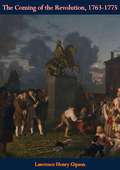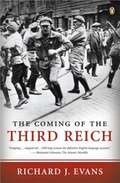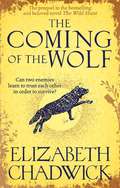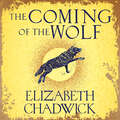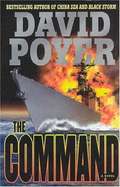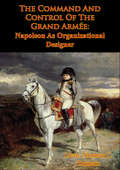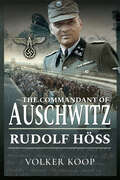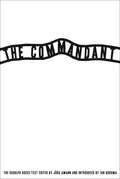- Table View
- List View
The Columbia History of the Vietnam War
by David L. AndersonAmerica's experience in Vietnam continues to figure prominently in debates over strategy and defense and within the discourse on the identity of the United States as a nation. Through fifteen essays rooted in recent scholarship, The Columbia History of the Vietnam War is a chronological and critical collective history central to any discussion of America's interests abroad. David Anderson opens with an essay on the Vietnam War's major themes and enduring relevance. Mark Philip Bradley (University of Chicago) reexamines the rise of Vietnamese revolutionary nationalism and the Vietminh-led war against French colonialism. Richard Immerman (Temple University) revisits Eisenhower's and Kennedy's efforts at nation-building in South Vietnam. Gary Hess (Bowling Green State University) reviews America's military commitment under Kennedy and Johnson, and Lloyd Gardner (Rutgers University) investigates the motivations behind Johnson's escalation of force. Robert McMahon (Ohio State University) focuses on the pivotal period before and after the Tet Offensive, and Jeffrey Kimball (Miami University) makes sense of Nixon's paradoxical decision to end U. S. intervention while pursuing a destructive air war. John Prados (National Security Archive) and Eric Bergerud (Naval Postgraduate School) devote their essays to America's military strategy. Helen Anderson (California State University, Monterey Bay) and Robert Brigham (Vassar College) explore the war's impact on Vietnamese women and urban culture. Melvin Small (Wayne State University) recounts the domestic tensions created by America's involvement in Vietnam, and Kenton Clymer (Northern Illinois University) follows the spread of the war to Laos and Cambodia. Concluding essays by Robert Schulzinger (University of Colorado) and George Herring (University of Kentucky) trace the legacy of the war within Vietnamese and American contexts and diagnose the symptoms of the "Vietnam Syndrome" evident in later U. S. foreign policy debates.
The Columbia History of the Vietnam War (Columbia Guides To American History And Cultures (coup) Ser.)
by Ed. Anderson David L.Rooted in recent scholarship, The Columbia History of the Vietnam War offers profound new perspectives on the political, historical, military, and social issues that defined the war and its effect on the United States and Vietnam. Laying the chronological and critical foundations for the volume, David L. Anderson opens with an essay on the Vietnam War's major moments and enduring relevance. Mark Philip Bradley follows with a reexamination of Vietnamese revolutionary nationalism and the Vietminh-led war against French colonialism. Richard H. Immerman revisits Eisenhower's and Kennedy's efforts at nation building in South Vietnam, and Gary R. Hess reviews America's military commitment under Kennedy and Johnson. Lloyd C. Gardner investigates the motivations behind Johnson's escalation of force, and Robert J. McMahon focuses on the pivotal period before and after the Tet Offensive. Jeffrey P. Kimball then makes sense of Nixon's paradoxical decision to end U.S. intervention while pursuing a destructive air war.John Prados and Eric Bergerud devote essays to America's military strategy, while Helen E. Anderson and Robert K. Brigham explore the war's impact on Vietnamese women and urban culture. Melvin Small recounts the domestic tensions created by America's involvement in Vietnam, and Kenton Clymer traces the spread of the war to Laos and Cambodia. Concluding essays by Robert D. Schulzinger and George C. Herring account for the legacy of the war within Vietnamese and American contexts and diagnose the symptoms of the "Vietnam syndrome" evident in later debates about U.S. foreign policy. America's experience in Vietnam continues to figure prominently in discussions about strategy and defense, not to mention within discourse on the identity of the United States as a nation. Anderson's expert collection is therefore essential to understanding America's entanglement in the Vietnam War and the conflict's influence on the nation's future interests abroad.
The Comanche Code Talkers of World War II
by William C. MeadowsThe true story of the US Army’s Comanche Code Talkers, from their recruitment and training to active duty in World War II and postwar life.Among the allied troops that came ashore in Normandy on D-Day, June 6, 1944, were thirteen Comanches in the 4th Infantry Division, 4th Signal Company. Under German fire they laid communications lines and began sending messages in a form never before heard in Europe?coded Comanche. For the rest of World War II, the Comanche Code Talkers played a vital role in transmitting orders and messages in a code that was never broken by the Germans.This book tells the full story of the Comanche Code Talkers for the first time. Drawing on interviews with all surviving members of the unit, their original training officer, and fellow soldiers, as well as military records and news accounts, William C. Meadows follows the group from their recruitment and training to their active duty in World War II and on through their postwar lives up to the present. He also provides the first comparison of Native American code talking programs, comparing the Comanche Code Talkers with their better-known Navajo counterparts in the Pacific and with other Native Americans who used their languages, coded or not, for secret communication. Meadows sets this history in a larger discussion of the development of Native American code talking in World Wars I and II, identifying two distinct forms of Native American code talking, examining the attitudes of the American military toward Native American code talkers, and assessing the complex cultural factors that led Comanche and other Native Americans to serve their country in this way.“Of all the books on Native American service in the U.S. armed forces, this is the best. . . . Readers will find the story of the Comanche Code Talkers compelling, humorous, thought-provoking, and inspiring.” —Tom Holm, author of Strong Hearts, Wounded Souls: Native American Veterans of the Vietnam War
The Comanche Code Talkers of World War II
by William C. MeadowsThe true story of the US Army’s Comanche Code Talkers, from their recruitment and training to active duty in World War II and postwar life.Among the allied troops that came ashore in Normandy on D-Day, June 6, 1944, were thirteen Comanches in the 4th Infantry Division, 4th Signal Company. Under German fire they laid communications lines and began sending messages in a form never before heard in Europe?coded Comanche. For the rest of World War II, the Comanche Code Talkers played a vital role in transmitting orders and messages in a code that was never broken by the Germans.This book tells the full story of the Comanche Code Talkers for the first time. Drawing on interviews with all surviving members of the unit, their original training officer, and fellow soldiers, as well as military records and news accounts, William C. Meadows follows the group from their recruitment and training to their active duty in World War II and on through their postwar lives up to the present. He also provides the first comparison of Native American code talking programs, comparing the Comanche Code Talkers with their better-known Navajo counterparts in the Pacific and with other Native Americans who used their languages, coded or not, for secret communication. Meadows sets this history in a larger discussion of the development of Native American code talking in World Wars I and II, identifying two distinct forms of Native American code talking, examining the attitudes of the American military toward Native American code talkers, and assessing the complex cultural factors that led Comanche and other Native Americans to serve their country in this way.“Of all the books on Native American service in the U.S. armed forces, this is the best. . . . Readers will find the story of the Comanche Code Talkers compelling, humorous, thought-provoking, and inspiring.” —Tom Holm, author of Strong Hearts, Wounded Souls: Native American Veterans of the Vietnam War
The Combat Codes (The Combat Codes #1)
by Alexander DarwinHundreds of years ago on a planet once ravaged by war, the nations swore an armistice never to use weapons of mass destruction again. Today, battle-hardened warriors known as Grievar Knights train to represent their nations' interests in brutal hand-to-hand combat. Murray Pearson was once a famed Knight until he suffered a loss that crippled his nation - but now he's on the hunt to find and train the next champion.Below, in the Underground's brutal combat rings, an orphaned boy called Cego is making a name for himself. Murray believes he has what it takes to make it in the planet's most prestigious combat school - but he has to fight his way out of the Underground first.
The Combat Codes (The Combat Codes #1)
by Alexander DarwinHundreds of years ago on a planet once ravaged by war, the nations swore an armistice never to use weapons of mass destruction again. Today, battle-hardened warriors known as Grievar Knights train to represent their nations' interests in brutal hand-to-hand combat. Murray Pearson was once a famed Knight until he suffered a loss that crippled his nation - but now he's on the hunt to find and train the next champion.Below, in the Underground's brutal combat rings, an orphaned boy called Cego is making a name for himself. Murray believes he has what it takes to make it in the planet's most prestigious combat school - but he has to fight his way out of the Underground first.
The Combat History of the 23rd Panzer Division in World War II
by Ernst RebentischFrom a WWII veteran, an illustrated military history of the German tank division that fought exclusively on the Eastern front. In 1939 and 1940, the German armored division Panzertruppe initiated a chain of victories that seemed unstoppable. In this account from Ernst Rebentisch, a member of the 23rd Panzer division during World War II, you&’ll find a history of the tank division unit that operated near Stalingrad and in Ukraine, Poland, Hungary, and Austria, relying heaving on captured enemy tanks such as Soviet T-34s. Containing eight pages of color vehicle profiles, this book is a valuable resource for armor modelers and military enthusiasts.
The Comet Kings
by Edmond HamiltonOne by one the Solar System's ships were disappearing in mid-space - as if a mighty colossus had grabbed them up and swallowed them whole.Top agents Joan Randall and Ezra Gurney were sent to investigate. Like the others, somewhere beyond Jupiter, they disappeared. Captain Future heard the news with shocked horror. Whatever the danger, he had to stop this menacing evil force. Whatever the risk, he had to find the lovely Joan Randall - the woman he loved...
The Coming
by Joe HaldemanAstronomy professor Aurora 'Rory' Bell gets a message from space that seems to portend the arrival of extraterrestrial visitors. According to her calculations, whoever is coming will arrive in three months - on New Year's Day to be exact.A crowded and poisoned Earth is moving toward the brink of the last world war - and is certainly unprepared to face invasion of any kind. Rory's continuing investigation leads her to wonder if it could be some kind of hoax, but the impending 'visit' takes on a media life of its own. And so the world waits. But the question still remains as to what, exactly, everyone is waiting for...
The Coming Conquest of England
by August NiemannThe Coming Conquest of England is a classic utopian novel that displayed the German lust for world domination long before either of the two world wars.
The Coming Draft: The Crisis in Our Military and Why Selective Service Is Wrong for America
by Philip GoldA frustrating war and an endless occupation. The very real prospect of more conflict overseas. A military stretched beyond its breaking point. The stage is set for the resumption of the draft. Now, in an explosive and provocative book, Philip Gold, a former Marine and a disaffected conservative, reveals why selective service should never come to pass but might.
The Coming Fury (The American Civil War Trilogy #1)
by Bruce CattonWinner of the Pulitzer Prize and the National Book Award! A thrilling, page-turning piece of writing that describes the forces conspiring to tear apart the United States--with the disintegrating political processes and rising tempers finally erupting at Bull Run. " . . . a major work by a major writer, a superb recreation of the twelve crucial months that opened the Civil War." --The New York Times
The Coming Storm: Test and First-Class Cricketers Killed in World War Two
by Nigel McCreryThe outbreak of the Second World War came towards the closing stages of the 1939 cricket season. Hitler permitted us almost to complete an exceptionally interesting season, Sir Home Gordon, wrote in the Cricketer magazine, When shall we see the stumps pitched again?As the West Indies touring team canceled their last five matches and sailed home before the U-boat threat developed, the treasures at Lords, including the Ashes, were sent to a secret location for safekeeping. The Marylebone Cricket Club cancelled its tour to India - England played under the MCC banner then.During the ensuing conflict twelve test cricketers (five English, two South Africans, one Australian and one New Zealander) perished together with 130 first class players. In this superbly researched sequel to Final Wicket, covering cricketing fatalities during The Great War, this book reveals each mans career details, including cricketing statistics, and the circumstances of death. There is also a brief history of the game during the War. Arguably the period between the two world wars was the golden age of cricket, and this book honors those who made it so only to die serving their countries in a different way.
The Coming of the Civil War [First Ed.]
by Avery O. CravenExcellent and detailed account of the causes behind the American Civil War by eminent historian Avery O. Craven."In recent years a highly industrious school of historians has begun asking whether the war should have been fought at all and whether it was perhaps not more the fault of the North than of the South. Seeking to revise earlier judgments they have become known as the revisionists, and one of the most gifted and studious of them all is Avery Craven, whose The Coming of the Civil War...is one of the landmarks of revisionist literature."—Bruce Catton, American Heritage"...those who would examine the democratic process during a period of progressive breakdown, in order to understand the dangers it embodies within itself, will find The Coming of the Civil War a classic analysis."—Louis D. Rubin, Jr., Sewanee Review"The book has always been recognized, even by its most severe critics, as a work of consummate scholarship."—T. Harry Williams, Baton Rouge Morning Advocate
The Coming of the Revolution, 1763-1775: The New American Nation Series
by Lawrence Henry GipsonA short history of the "rise of that historical movement which culminates in American secession from the British Empire. Includes descriptions of the individual colonies and their characteristics.”“Professor Gipson’s magisterial narrative of the Revolutionary movement within the thirteen American colonies meets both the special needs of the editors and the high standards of the author—an achievement that is not, as we have learned from other books in other series, the easiest thing in the scholarly world to bring off successfully. Out of the massive rock of this knowledge and understanding of the British Empire in America, he has carved a gem of descriptive narration and reflective judgment. The Coming of the Revolution is ‘pure Gipson,’ that is to say, a book about early America that is documented with severity, written with clarity, and marked by a measured, one might almost say Franklinian, affection for the old Empire.”—CLINTON ROSSITER, The Annals of The American Academy for Political and Social Science“Like all his work, this bears all the marks of sound learning, just temper, and love of truth and reality. This, surely, is the best short history of the rise of that historical movement which culminates in American secession from the British Empire.”—ROSS J. S. HOFFMAN, Fordham University
The Coming of the Third Reich: A History
by Richard J. EvansFrom one of the world's most distinguished historians, a magisterial new reckoning with Hitler's rise to power and the collapse of civilization in Nazi Germany. In 1900 Germany was the most progressive and dynamic nation in Europe, the only country whose rapid technological and social growth and change challenged that of the United States. Its political culture was less authoritarian than Russia's and less anti-Semitic than France's; representative institutions were thriving, and competing political parties and elections were a central part of life. How then can we explain the fact that in little more than a generation this stable modern country would be in the hands of a violent, racist, extremist political movement that would lead it and all of Europe into utter moral, physical, and cultural ruin?
The Coming of the Third Reich: How The Nazis Destroyed Democracy And Seized Power In Germany (The History of the Third Reich #1)
by Richard J. EvansThere is no story in twentieth-century history more important to understand than Hitler's rise to power and the collapse of civilization in Nazi Germany. With The Coming of the Third Reich, Richard Evans, one of the world's most distinguished historians, has written the definitive account for our time. A masterful synthesis of a vast body of scholarly work integrated with important new research and interpretations, Evans's history restores drama and contingency to the rise to power of Hitler and the Nazis, even as it shows how ready Germany was by the early 1930s for such a takeover to occur. The Coming of the Third Reich is a masterwork of the historian's art and the book by which all others on the subject will be judged.
The Coming of the Wolf: The Wild Hunt series prequel
by Elizabeth ChadwickShortlisted for the RNA Historical Romantic Novel AwardThe long-awaited prequel to Elizabeth Chadwick's bestselling and beloved first novel The Wild Hunt'Picking up an Elizabeth Chadwick novel you know you are in for a sumptuous ride'Daily TelegraphThe Welsh Borders, 1069 When Ashdyke Manor is attacked, Lady Christen is forced to witness her husband's murder and the pillaging of her lands at the hands of brutal Norman invaders. It seems the pain is finally over when Miles Le Gallois, Lord of Milnham-on-Wye, calls off the attack. But he has Christen's brother under armed guard and a deal to offer: her brother's freedom for her hand in marriage. Christen finds herself hastily married into the enemy side, with her brother swearing his vengeance on her new husband. Miles and Christen's precarious union invites enemies from all sides and when Miles is summoned for a lengthy campaign by the King, Christen is left to watch his lands. In the midst of war, two enemies must somehow learn to trust one another if they are to survive . . .Praise for Elizabeth Chadwick 'An author who makes history come gloriously alive'The Times 'Stunning . . . Her characters are beguiling, and the story is intriguing'Barbara Erskine 'Meticulous research and strong storytelling'Woman & Home
The Coming of the Wolf: The Wild Hunt series prequel (Wild Hunt #4)
by Elizabeth ChadwickThe long-awaited prequel to Elizabeth Chadwick's bestselling and beloved first novel The Wild Hunt'Picking up an Elizabeth Chadwick novel you know you are in for a sumptuous ride'Daily Telegraph The Welsh Borders, 1069 When Ashdyke Manor is attacked, Lady Christen is forced to witness her husband's murder and the pillaging of her lands at the hands of brutal Norman invaders. It seems the pain is finally over when Miles Le Gallois, Lord of Milnham-on-Wye, calls off the attack. But he has Christen's brother under armed guard and a deal to offer: her brother's freedom for her hand in marriage. Christen finds herself hastily married into the enemy side, with her brother swearing his vengeance on her new husband. Miles and Christen's precarious union invites enemies from all sides and when Miles is summoned for a lengthy campaign by the King, Christen is left to watch his lands. In the midst of war, two enemies must somehow learn to trust one another if they are to survive . . .Praise for Elizabeth Chadwick 'An author who makes history come gloriously alive'The Times 'Stunning . . . Her characters are beguiling, and the story is intriguing'Barbara Erskine 'I rank Elizabeth Chadwick with such historical novelist stars as Dorothy Dunnett and Anya Seton'Sharon Kay Penman 'Enjoyable and sensuous'Daily Mail'Meticulous research and strong storytelling'Woman & Home 'A riveting read . . . A glorious adventure not to be missed!'Candis
The Coming of the Wolf: The Wild Hunt series prequel (Wild Hunt #4)
by Elizabeth ChadwickShortlisted for the RNA Historical Romantic Novel AwardThe long-awaited prequel to Elizabeth Chadwick's bestselling and beloved first novel The Wild Hunt'Picking up an Elizabeth Chadwick novel you know you are in for a sumptuous ride'Daily Telegraph The Welsh Borders, 1069 When Ashdyke Manor is attacked, Lady Christen is forced to witness her husband's murder and the pillaging of her lands at the hands of brutal Norman invaders. It seems the pain is finally over when Miles Le Gallois, Lord of Milnham-on-Wye, calls off the attack. But he has Christen's brother under armed guard and a deal to offer: her brother's freedom for her hand in marriage. Christen finds herself hastily married into the enemy side, with her brother swearing his vengeance on her new husband. Miles and Christen's precarious union invites enemies from all sides and when Miles is summoned for a lengthy campaign by the King, Christen is left to watch his lands. In the midst of war, two enemies must somehow learn to trust one another if they are to survive . . .Praise for Elizabeth Chadwick 'An author who makes history come gloriously alive'The Times 'Stunning . . . Her characters are beguiling, and the story is intriguing'Barbara Erskine 'I rank Elizabeth Chadwick with such historical novelist stars as Dorothy Dunnett and Anya Seton'Sharon Kay Penman 'Enjoyable and sensuous'Daily Mail'Meticulous research and strong storytelling'Woman & Home 'A riveting read . . . A glorious adventure not to be missed!'Candis
The Command (A Dan Lenson Novel #8)
by David PoyerAfter receiving the Congressional Medal of Honor for action in Iraq, Commander Daniel V. Lenson is given new orders: "Take over as skipper of USS Thomas W. Horn." His mission: Prepare the Tomahawk-equipped strike destroyer and her crew for the Red Sea, where she'll join an international task force searching for weapons of mass destruction. But this will be no routine deployment. Horn will be the first U.S. Navy warship ever to deploy with an integrated male and female crew-a controversial and politically explosive experiment that will raise questions about morale, behavior, training, sexual attraction, and ultimately, performance under fire. Facing sandstorms, smugglers, and ambushes, Horn's increasingly polarized crew will conduct demanding, diplomatically sensitive search-and-seizure operations against foreign vessels attempting to smuggle arms to Iraq. But the real nightmare is brewing in Bahrain. There, the most dangerous bomb expert in Al-Qaeda has targeted Horn for attack as the first step in a plan to redraw the map of the whole Middle East. With gripping action scenes and an explosive climax, The Command continues Dan Lenson's star-crossed career in a series that explores both global and deeply personal implications of honor, duty, power, and war.
The Command And Control Of The Grand Armée: Napoleon As Organizational Designer
by Lieut. Norman L. DurhamThe purpose of this thesis is to investigate Napoleon Bonaparte's command and control of the Grand Armée through the lens of organizational design. Napoleon's methodology behind the design of the Grand Armée is analyzed using modern principles of organizational design. The structure that Napoleon created within his organizational design was a vast information network that served as the framework for a highly effective command and control system. This command and control network allowed Napoleon to dominate a war with his enemies within the information domain.The Grand Armée transited the European countryside with lightning speed as Napoleon out maneuvered his enemies. Napoleon's dominance was a direct result of his organizational masterpiece that was the Grand Armée. From an organizational design perspective, Napoleon's methodology applied the ideas of others and exploited existing technology to affect his design.The reorganization of the military corps became one of the most important transformations made by Napoleon. The army corps was considered a key component in Napoleon's strategic deployments. The command and control system he engineered for his corps was essential in the Napoleonic philosophy to march divided and fight united.
The Commandant of Auschwitz: Rudolf Höss
by Volker KoopThe renowned WWII historian&’s definitive biography of the notorious German SS officer convicted of war crimes for his role in the Holocaust. Described as one of the greatest mass-murderers in history, Rudolf Höss was the longest-serving commandant of the Auschwitz concentration and extermination camps in Nazi-occupied Poland. He was one of the chief architects behind Hitler&’s Final Solution. In The Commandant of Auschwitz, Volker Koop details Höss&’s military career, his conversion to Nazi ideology, and his ruthless commitment to the Nazi cause. At the age of fourteen, Höss joined the 21st Regiment of Dragoons and rose through the ranks to become the youngest non-commissioned officer in the German Army. After joining the Nazi party in 1922, he was convicted of participating in at least one political assassination, for which he spent six years in prison. In 1934, Höss became a Block Leader at Dachau concentration camp. By 1940, he would be given command of his own camp near the town of Auschwitz. Charged with carrying out the Final Solution of the Jewish question, Höss set about his task with relish. By his own estimation, he was responsible for the deaths of at least 3,000,000 individuals. Justice caught up with Höss after the German surrender. He was arrested on March 11th, 1946, after a year of posing as a gardener under a false name. He was found guilty of war crimes and hanged on April 16th, 1947.
The Commandant of Auschwitz: Rudolf Höss
by Volker KoopThe renowned WWII historian&’s definitive biography of the notorious German SS officer convicted of war crimes for his role in the Holocaust. Described as one of the greatest mass-murderers in history, Rudolf Höss was the longest-serving commandant of the Auschwitz concentration and extermination camps in Nazi-occupied Poland. He was one of the chief architects behind Hitler&’s Final Solution. In The Commandant of Auschwitz, Volker Koop details Höss&’s military career, his conversion to Nazi ideology, and his ruthless commitment to the Nazi cause. At the age of fourteen, Höss joined the 21st Regiment of Dragoons and rose through the ranks to become the youngest non-commissioned officer in the German Army. After joining the Nazi party in 1922, he was convicted of participating in at least one political assassination, for which he spent six years in prison. In 1934, Höss became a Block Leader at Dachau concentration camp. By 1940, he would be given command of his own camp near the town of Auschwitz. Charged with carrying out the Final Solution of the Jewish question, Höss set about his task with relish. By his own estimation, he was responsible for the deaths of at least 3,000,000 individuals. Justice caught up with Höss after the German surrender. He was arrested on March 11th, 1946, after a year of posing as a gardener under a false name. He was found guilty of war crimes and hanged on April 16th, 1947.
The Commandant: An Account by the First Commanding Officer of Auschwitz
by Rudolf HoessThis chilling memoir presents “a graphic and compelling self-portrait” of the Nazi war criminal who oversaw Auschwitz concentration camp (Jewish Book World).SS officer Rudolph Hoess was the longest-serving commandant of Auschwitz. After the war, he was convicted of war crimes and sentenced to death by the Polish Supreme National Tribunal. The amoral sensibility Hoess displayed regarding all that went on in the charnel factory where the industrialization of death was practiced—where probably three million people were literally worked to death, shot or gassed—is still almost beyond belief today. Editor Jurg Amann has taken Hoess's text and produced a work of vital historical importance. The Commandant presents an excruciating insight into Hitler's Final Solution and the nature of evil itself through the prism of the Nazis' totalitarian system, one Hoess and so many others felt no need to question. Ian Buruma's introduction sets this frightening work within a both moral and historical context.
